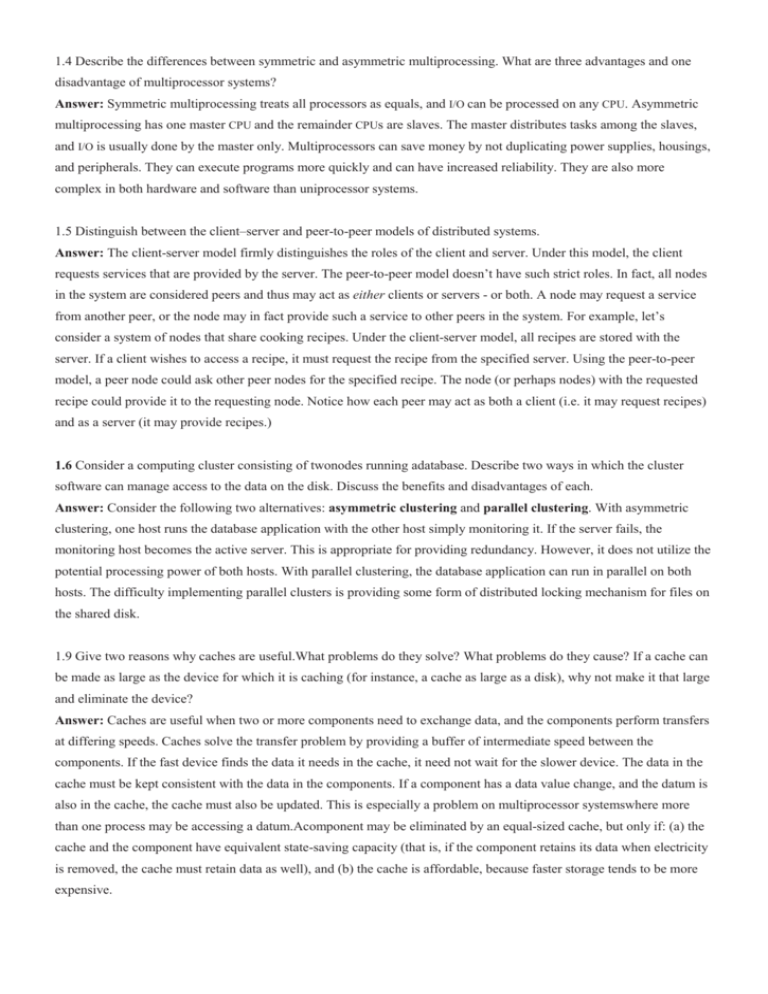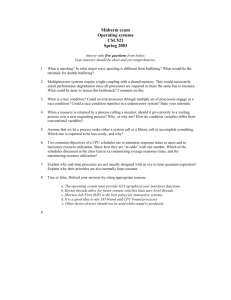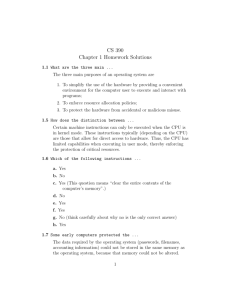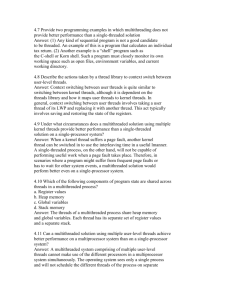Document
advertisement

1.4 Describe the differences between symmetric and asymmetric multiprocessing. What are three advantages and one
disadvantage of multiprocessor systems?
Answer: Symmetric multiprocessing treats all processors as equals, and I/O can be processed on any CPU. Asymmetric
multiprocessing has one master CPU and the remainder CPUs are slaves. The master distributes tasks among the slaves,
and I/O is usually done by the master only. Multiprocessors can save money by not duplicating power supplies, housings,
and peripherals. They can execute programs more quickly and can have increased reliability. They are also more
complex in both hardware and software than uniprocessor systems.
1.5 Distinguish between the client–server and peer-to-peer models of distributed systems.
Answer: The client-server model firmly distinguishes the roles of the client and server. Under this model, the client
requests services that are provided by the server. The peer-to-peer model doesn’t have such strict roles. In fact, all nodes
in the system are considered peers and thus may act as either clients or servers - or both. A node may request a service
from another peer, or the node may in fact provide such a service to other peers in the system. For example, let’s
consider a system of nodes that share cooking recipes. Under the client-server model, all recipes are stored with the
server. If a client wishes to access a recipe, it must request the recipe from the specified server. Using the peer-to-peer
model, a peer node could ask other peer nodes for the specified recipe. The node (or perhaps nodes) with the requested
recipe could provide it to the requesting node. Notice how each peer may act as both a client (i.e. it may request recipes)
and as a server (it may provide recipes.)
1.6 Consider a computing cluster consisting of twonodes running adatabase. Describe two ways in which the cluster
software can manage access to the data on the disk. Discuss the benefits and disadvantages of each.
Answer: Consider the following two alternatives: asymmetric clustering and parallel clustering. With asymmetric
clustering, one host runs the database application with the other host simply monitoring it. If the server fails, the
monitoring host becomes the active server. This is appropriate for providing redundancy. However, it does not utilize the
potential processing power of both hosts. With parallel clustering, the database application can run in parallel on both
hosts. The difficulty implementing parallel clusters is providing some form of distributed locking mechanism for files on
the shared disk.
1.9 Give two reasons why caches are useful.What problems do they solve? What problems do they cause? If a cache can
be made as large as the device for which it is caching (for instance, a cache as large as a disk), why not make it that large
and eliminate the device?
Answer: Caches are useful when two or more components need to exchange data, and the components perform transfers
at differing speeds. Caches solve the transfer problem by providing a buffer of intermediate speed between the
components. If the fast device finds the data it needs in the cache, it need not wait for the slower device. The data in the
cache must be kept consistent with the data in the components. If a component has a data value change, and the datum is
also in the cache, the cache must also be updated. This is especially a problem on multiprocessor systemswhere more
than one process may be accessing a datum.Acomponent may be eliminated by an equal-sized cache, but only if: (a) the
cache and the component have equivalent state-saving capacity (that is, if the component retains its data when electricity
is removed, the cache must retain data as well), and (b) the cache is affordable, because faster storage tends to be more
expensive.
2.5 What is the purpose of the command interpreter? Why is it usually separate from the kernel? Would it be possible for
the user to develop a new command interpreter using the system-call interface provided by the operating system?
Answer: It reads commands from the user or from a file of commands and executes them, usually by turning them into
one or more system calls. It is usually not part of the kernel since the command interpreter is subject to changes. An user
should be able to develop a new command interpreter using the system-call interface provided by the operating system.
The command interpreter allows an user to create and manage processes and also determine ways by which they
communicate (such as through pipes and files). As all of this functionality could be accessed by an user-level program
using the system calls, it should be possible for the user to develop a new command-line interpreter.
2.9 In what ways is the modular kernel approach similar to the layered approach? In what ways does it differ from the
layered approach?
Answer: The modular kernel approach requires subsystems to interact with each other through carefully constructed
interfaces that are typically narrow (in terms of the functionality that is exposed to external modules). The layered kernel
approach is similar in that respect. However, the layered kernel imposes a strict ordering of subsystems such that
subsystems at the lower layers are not allowed to invoke operations corresponding to the upper-layer subsystems. There
are no such restrictions in the modular-kernel approach, wherein modules are free to invoke each other without any
constraints.
3.1 Describe the differences among short-term, medium-term, and longterm scheduling.
Answer:
• Short-term (CPU scheduler)—selects from jobs in memory those jobs that are ready to execute and allocates the CPU to
them.
• Medium-term—used especially with time-sharing systems as an intermediate scheduling level. A swapping scheme is
implemented to remove partially run programs from memory and reinstate them later to continue where they left off.
• Long-term (job scheduler)—determines which jobs are brought into memory for processing. The primary difference is
in the frequency of their execution. The shortterm must select a new process quite often. Long-term is usedmuch less
often since it handles placing jobs in the system and may wait a while for a job to finish before it admits another one.
3.4 What are the benefits and detriments of each of the following? Consider both the systems and the programmers’
levels.
a. Symmetric and asymmetric communication
b. Automatic and explicit buffering
c. Send by copy and send by reference
d. Fixed-sized and variable-sized messages
Answer:
a. Symmetric and asymmetric communication - A benefit of symmetric communication is that it allows a rendezvous
between the sender and receiver. A disadvantage of a blocking send is that a rendezvous may not be required and the
message could be delivered asynchronously; received at a point of no interest to the sender. As a result, message-passing
systems often provide both forms of synchronization.
b. Automatic and explicit buffering -Automatic buffering provides a queuewith indefinite length; thus ensuring the
senderwill never have to block while waiting to copy a message. There are no specifications how automatic buffering
will be provided; one scheme may reserve sufficiently large memory where much of the memory is wasted. Explicit
buffering specifies how large the buffer is. In this situation, the sender may be blocked while waiting for available space
in the queue. However, it is less likely memory will be wasted with explicit buffering.
c. Send by copy and send by reference - Send by copy does not allow the receiver to alter the state of the parameter;
send by reference does allow it.Abenefit of send by reference is that it allows the programmer towrite a distributed
version of a centralized application. Java’s RMI provides both, however passing a parameter by reference requires
declaring the parameter as a remote object as well.
d. Fixed-sized and variable-sized messages - The implications of this are mostly related to buffering issues; with
fixed-size messages, a buffer with a specific size can hold a known number of messages. The number of variable-sized
messages that can be held by such a buffer is unknown. Consider how Windows 2000 handles this situation: with
fixed-sizedmessages (anything < 256 bytes), the messages are copied from the address space of the sender to the address
space of the receiving process. Larger messages (i.e. variable-sized messages) use shared memory to pass the message.
4.4 Can a multithreaded solution using multiple user-level threads achieve betterperformance on amultiprocessor system
than on a single-processor system?
Answer: A multithreaded system comprising of multiple user-level threads cannot make use of the different processors
in a multiprocessor system simultaneously. The operating system sees only a single process and will not schedule the
different threads of the process on separate processors. Consequently, there is no performance benefit associated with
executing multiple user-level threads on a multiprocessor system.
4.6 Consider amultiprocessor system and a multithreaded program written using the many-to-many threading model. Let
the number of user-level threads in the program be more than the number of processors in the system.Discuss the
performance implications of the following scenarios.
a. The number of kernel threads allocated to the program is less than the number of processors.
b. The number of kernel threads allocated to the program is equal to the number of processors.
c. The number of kernel threads allocated to the program is greater than the number of processors but less than the
number of userlevel threads.
Answer: When the number of kernel threads is less than the number of processors, then some of the processors would
remain idle since the scheduler maps only kernel threads to processors and not user-level threads to processors. When the
number of kernel threads is exactly equal to the number of processors, then it is possible that all of the processors might
be utilized simultaneously. However, when a kernelthread blocks inside the kernel (due to a page fault or while invoking
system calls), the corresponding processor would remain idle. When there are more kernel threads than processors, a
blocked kernel thread could be swapped out in favor of another kernel thread that is ready to execute, thereby increasing
the utilization of the multiprocessor system.
4.8 The Fibonacci sequence
/*
* @author Gagne, Galvin, Silberschatz
* Operating System Concepts
- Seventh Edition
* Copyright John Wiley & Sons - 2005.
*/
#include <stdio.h>
#include <windows.h>
/** we will only allow up to 256 Fibonacci numbers */
#define MAX_SIZE 256
int fibs[MAX_SIZE];
/* the thread runs in this separate function */
DWORD WINAPI Summation(PVOID Param)
{
DWORD upper = *(DWORD *)Param;
int i;
if (upper== 0)
return 0;
else if (upper == 1)
fibs[0] = 0;
else if (upper== 2) {
fibs[0] = 0;
fibs[1] = 1;
}
else { // sequence > 2
fibs[0] = 0;
fibs[1] = 1;
for (i = 2; i < upper; i++)
fibs[i] = fibs[i-1] + fibs[i-2];
}
return 0;
}
int main(int argc, char *argv[])
{
DWORD ThreadId;
HANDLE ThreadHandle;
int Param;
// do some basic error checking
if (argc != 2) {
fprintf(stderr,"An integer parameter is required\n");
return -1;
}
Param = atoi(argv[1]);
if ( (Param < 0) || (Param > 256) ) {
fprintf(stderr, "an integer >= 0 and < 256 is required \n");
return -1;
}
// create the thread
ThreadHandle = CreateThread(NULL, 0, Summation, &Param, 0, &ThreadId);
if (ThreadHandle != NULL) {
WaitForSingleObject(ThreadHandle, INFINITE);
CloseHandle(ThreadHandle);
/** now output the Fibonacci numbers */
for (int i = 0; i < Param; i++)
printf("%d\n", fibs[i]);
}
}
5.1 Discuss how the following pairs of scheduling criteria conflict in certain settings.
a. CPU utilization and response time
b. Average turnaround time and maximum waiting time
c. I/O device utilization and CPU utilization
Answer:
• CPU utilization and response time: CPU utilization is increased if the overheads associated with context switching is
minimized. The context switching overheads could be lowered by performing context switches infrequently. This could
however result in increasing the response time for processes.
• Average turnaround time and maximum waiting time: Average turnaround time is minimized by executing the shortest
tasks first. Such a scheduling policy could however starve long-running tasks and thereby increase their waiting time.
• I/O device utilization and CPU utilization: CPU utilization is maximized by running long-running CPU-bound tasks
without performing context switches. I/O device utilization is maximized by scheduling I/O-bound jobs as soon as they
become ready to run, thereby incurring the overheads of context switches.
5.2 Consider the following set of processes, with the length of the CPU-burst time given in milliseconds:
Process
Burst Time
Priority
P1
10
3
P2
1
1
P3
2
3
P4
1
4
P5
5
2
The processes are assumed to have arrived in the order P1, P2, P3, P4, P5, all at time 0.
a. Draw four Gantt charts illustrating the execution of these processes using FCFS, SJF, a nonpreemptive priority (a
smaller priority number implies a higher priority), and RR (quantum = 1) scheduling.
b. What is the turnaround time of each process for each of the scheduling algorithms in part a?
c. What is thewaiting time of each process for each of the scheduling algorithms in part a?
d. Which of the schedules in part a results in the minimal average waiting time (over all processes)?
Answer:
a. The four Gantt charts (自己畫)
b. Turnaround time
FCFS
RR
SJF
Priority
P1
10
19
19
16
P2
11
2
1
1
P3
13
7
4
18
P4
14
4
2
19
P5
19
14
9
6
c. Waiting time (turnaround time minus burst time)
RR
P1
0
9
9
6
P2
10
1
0
0
P3
11
5
2
16
P4
13
3
1
18
P5
14
9
4
1
d. Shortest Job First
SJF
Priority
FCFS








